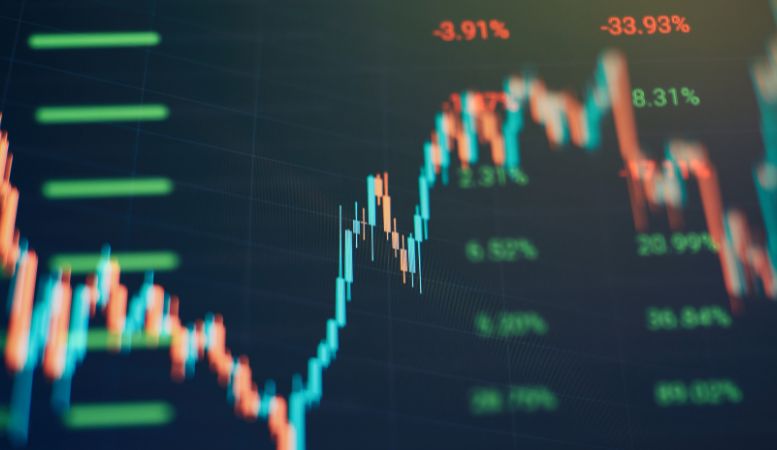Table of Contents
Gold is a traditional safe-haven investment that retains value even when markets collapse and central banks encounter crises. However, like every other commodity, gold is susceptible to price fluctuations. Many financial experts point out a connection between gold prices and several economic factors, including interest rates.
If you hold physical gold or are considering buying gold as an investment, it’s important to understand the possible interplay between the price of gold and interest rates.
The Correlation Between Gold Price and Interest Rates
Historically, there has been a negative correlation between interest rates and gold prices. Although it’s not a clear-cut formula, gold prices tend to spike when interest rates fall and decrease when interest rates climb.
Why does this happen? One possible explanation is that investors flock to investments with a higher annual yield. When stocks and other dynamic investments have high growth potential, investors are more incentivized to buy such assets. On the other hand, when stocks lose their value and the economy seems bleak, investors turn to gold as a stable commodity that can preserve wealth when the value of other assets deteriorates.
What Happens to Gold Prices When Interest Rates Rise?

Economic confidence grows in a robust market. Metrics like a rising Consumer Confidence Index (CCI) show people are optimistic about the economy. Businesses expand, and people spend more, borrow more, and invest more in assets like stocks and bonds. In a positive financial climate like this, central banks may expect higher returns and interest rates to rise.
When the economy enjoys a prosperous time and the interest rates strengthen the domestic currency, people tend to think less about safe-haven investments. There’s decreased interest in gold as a hedge fund, and gold prices often decrease.
What Happens to Gold Prices When Interest Rates Fall?
When economic growth slows, economic confidence decreases, and interest rates flatten or fall. Living costs rise, wages stop growing or decrease, and unemployment often spikes. The national currency may undergo devaluation, and investments like stocks and bonds produce low annual yields.
In an economic climate like that, investors turn to gold for two reasons. First, people want to lock in at least part of their funds in a safe, universally recognizable precious metal that has remained a desirable commodity since antiquity. The reasoning is that even if all other investments collapse, gold will always have buyers.
Second, unlike stocks, gold doesn’t yield extra annual income. This can seem like a drawback in a prosperous economy: Why buy gold and gain nothing when you can buy stocks and see your wealth grow? But when other investments also stagnate, gold seems more attractive thanks to its stability.
When more people rush to buy gold, its prices rise due to basic supply and demand principles.
A Historical Look at Gold Prices and Interest Rates

So, do prices of gold in relation to interest rates follow a simple seesaw dynamic, with one always going up as the other falls? The reality is more complex than that. History has seen periods of interest rates and gold prices rising and decreasing simultaneously. Gold is a global commodity that reacts to many forces the Federal Reserve can’t control, like supply and demand, reserve amounts, mining costs, and geopolitical factors.
When Gold Prices Behave “as Expected”
During the Great Recession of 2008-09, interest rates went down while gold prices climbed, aligning with the dynamics mentioned above. More recently, in 2020, when the Federal Reserve brought rates down to nearly zero during the COVID pandemic, gold prices boomed. In 2022, when the Fed increased interest rates to offset inflation, gold prices began to decline.
Gold Prices Can Surprise Investors
In the past, gold prices also showed many unforeseen up- and downswings. For instance, after the Black Death decimated nearly 50% of the population in 14th-century Europe, gold prices plummeted for a simple reason: There were far fewer people to buy gold.
However, the gold market can be unpredictable, even under extreme circumstances like COVID-19. For instance, in the 1970s, interest rates went up, but so did gold prices, peaking in 1980 after the Soviet Union invaded Afghanistan. In the following decade, interest rates declined, yet gold experienced a bear market.
Many elements influence gold prices, and there’s no guarantee prices will go up during a slower economy or drop when the stock market flourishes. Unique social and geopolitical circumstances may nudge gold prices in an unexpected direction. War and economic turmoil may make gold more attractive to investors. Central banks can influence gold prices by buying gold reserves.
What Other Factors Affect the Price of Gold?

Apart from the interplay between the prices of gold and interest rates, related economic factors, like inflation and domestic currency value, influence gold prices.
Inflation
During periods of high inflation, goods, services, the cost of living, and other commodities cost more. Purchasing power decreases, so people tighten their belts and spend less. Businesses lose revenue, lay off workers, and often close. The Federal Reserve raises interest rates to halt the economy and lower inflation, but some economic factors are beyond the Fed’s control.
During high inflation, stock prices drop, and many investors look to move funds from stocks and other volatile assets to gold. Thus, gold is in higher demand, and its prices tend to rise during inflation.
US Dollar Strength
In general, the price of gold has an inverse relationship to the strength of the US dollar. Since gold is dollar-denominated, when the US dollar is stronger, gold prices are usually lower. When the dollar falls, the same amount of other currencies can purchase more gold, so buyer interest may increase, driving prices up.
Dollar strength is also tightly linked to inflation: The US dollar weakens during inflation, and as inflation goes up, gold prices tend to follow suit.
Real Interest Rates
When you place funds in stocks or another investment, inflation will eat away at your investment’s rate of return. For instance, if your stocks yield a 5% nominal rate of return while the inflation rate is 2%, the real interest rate will be 3% once you deduce the inflation rate.
Like other factors we mentioned, the real interest rate may correlate negatively with gold prices. In other words, as real interest rates go up, one can expect to see a decline in gold prices (and vice versa).
Does this mean an active recession is a bad time for buying gold? Not necessarily. Although you should consult a financial advisor before making any major investment, in general, when you buy pure gold, you can be assured of a safe commodity with a high resale value. As is obvious by perusing our gold price charts, gold prices shift but remain relatively stable over time.
Diversify Your Investment Portfolio With Quality Gold Products
Are you looking to add gold to your investment portfolio? At Oxford Gold Group, we offer high-purity gold bars, gold coins, and other gold products. Complete our contact form to claim your free copy of our Complete Precious Metals Investment Guide and learn more about the prices of gold vs. interest rates and other aspects of investing in physical gold. When you’re ready to purchase, contact one of our helpful specialists.








